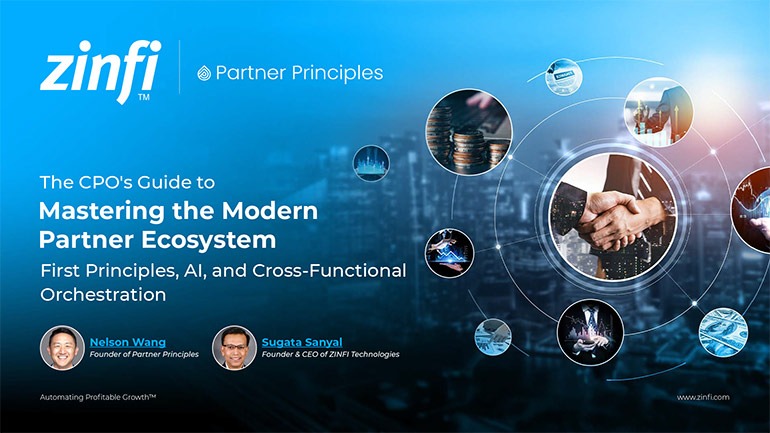Best Practices Articles

5 Myths of Channel Management
A significant portion of both B2B and B2C sales are made through a network of partners and resellers. Even today, however, most companies have antiquated channel management tools that do not live up to the full promise of their partner network. Only a very few organizations adequately invest in upgrading their channel management infrastructure, due to certain channel management misconceptions. In this article we will explore some of the common myths that impact not only the operational efficiency but also undermine the real truth about all channel networks.
- Partners are my indirect sales team – Nothing could be further away from the truth. While partners do have sales capability and most organizations tend to treat their partners as if they are an extension of their sales force, the reality is that partners are customers. While partners are certainly vocal and their feedback is critical because they run their own businesses, they do not regard a vendor as their equal. Maybe this is not the case if you are running a multi-outlet franchise, but when it comes to a traditional, two or three tier distribution channel, partners are their own bosses. There is no question that they do not work for their vendors. They work for their customers and for themselves. It follows that the way you manage your direct sales force as opposed to this indirect sales force should be planned and executed differently. This is where you need state-of-the-art channel management infrastructure.
- My partners are loyal – Yes, it is true to some extent, but their loyalty is really directed towards their own customer base and their employees. At the end of the day, their loyalty to a vendor comes last. Organizations that perceive their partners’ lack of receptiveness to competitors may perceive this as loyalty are completely misreading how the partner truly feels about the relationship. Yes, they may be engaged, and sell a lot of products, but their loyalty is to themselves and their relationships are based on the logic of what works for them. They are running a business, but not a frat house. Building partner loyalty requires deeper understanding, based on a structured approach towards channel management – starting with partner profiling, offer alignment, partner enablement and incentives management. Just as, if you want to build employee loyalty you need to think about their needs, in the same way it is critical to understand and deliver what partners care about. Most channel initiatives tend to be company centric vs. partner centric, and this is why they tend to fail.
- Partners will drive demand – Until and unless your partners are large distributors or national retailer/retailers, do not expect your partners to have the marketing capability to drive demand. Mature channel management organizations do not expect their sales people to drive their own demand; rather they deploy fully capable marketing processes, automation, programs and people. Similarly, your partners are your fulfillment arms, so you have to bring either a fully integrated marketing capability to them or provide them with sales-ready leads. The general expectation is that if a partner is getting commission they will naturally generate leads and close deals. This is a fallacy, but one which most organizations are not willing to relinquish. This expectation is not realistic, because it’s outside the resources and competency of most partners.
- The partner council knows it all – Most vendors selling through the channel tend to create partner councils to stay connected with the market place. While this is certainly an appropriate channel management approach in that it helps keep a pulse on the channel, it should also be kept in mind that this is only a small cross-section (and may not be a true and complete representation) of the entire channel. We have seen companies making grave mistakes in product pricing and distribution strategies when they listen to a small group of highly influential partners and use this as a basis for changing their go-to-market approaches. At the end of the day, everyone on the partner council wants to protect their own interests. While there may be some good Samaritans that watch out for others, in reality it is the company’s responsibility to truly determine what the ENTIRE market wants rather than listening to the demands of just one group of people.
- Deploy point tools for channel management – Most organizations today tend to use a set of discreet channel management and automation tools. The common belief is that if you have cobbled together the best-in-class point solutions the result will be a great channel management platform. The irony is that this is rarely the case. Data does not flow seamlessly from one system to another, channel teams end up relying significantly on IT configuration teams, and both deployment and operating costs increase substantially. Setting aside the issue of costs, discrete sets of tools also cause problems in ease-of-use and as a result most people do not use all the tools within different modules. The only way to overcome this is to use a best in class, unified partner management platform.
We all recognize that channel management is not an easy task. However most of the time organizations’ investments in this area are barely adequate. They rarely make significant investments either in automating the workflow or in creating a partner experience that is up to the expected level of any customer and provider relationship today. If your organization lacks an understanding and acceptance of the nature of the relationship with your partners, the chances are that most of your channel management infrastructure is likely to be outdated and not insufficiently upgraded. When a company takes the correct steps in defining the channel management workflow and automating some or most of the processes, and are able to manage based on data and facts, they tend to see a significant increase not only in channel productivity but also in revenue growth and partner satisfaction rates.
Best Practices Guides
 First Principles Drive Modern Partner Ecosystem Success Best Practices
First Principles Drive Modern Partner Ecosystem Success Best PracticesDownload for FREE
 The Future of Managed Service Providers: Navigating the Age of AI and Automation
The Future of Managed Service Providers: Navigating the Age of AI and AutomationDownload for FREE
 Modernizing Channel Marketing: AI and Ecosystem Enablement Best Practices
Modernizing Channel Marketing: AI and Ecosystem Enablement Best PracticesDownload for FREE
 The Channel’s Shift to Partner-Led With AI Best Practices
The Channel’s Shift to Partner-Led With AI Best PracticesDownload for FREE
 Hyperscalers, ISVs, and AI: Shaping the Future of B2B Software Distribution
Hyperscalers, ISVs, and AI: Shaping the Future of B2B Software DistributionDownload for FREE
 Definitive Guide to a Partner Ecosystem-First Sales Strategy
Definitive Guide to a Partner Ecosystem-First Sales StrategyDownload for FREE
 The Partner-Led Digital and AI Transformation Best Practices
The Partner-Led Digital and AI Transformation Best PracticesDownload for FREE
 Startup Talent Recruitment: Hiring Missionaries, Not Mercenaries
Startup Talent Recruitment: Hiring Missionaries, Not MercenariesDownload for FREE
 The Future of Partner Relationship Management with AI in Partnerships
The Future of Partner Relationship Management with AI in PartnershipsDownload for FREE
 Cybersecurity for the 99%: Strategies from the Frontline
Cybersecurity for the 99%: Strategies from the FrontlineDownload for FREE
 Mastering Partner Relationships: A Strategic Approach to Business Growth
Mastering Partner Relationships: A Strategic Approach to Business GrowthDownload for FREE
 Mastering Partner Relationship Management: Keys to SaaS Channel Success
Mastering Partner Relationship Management: Keys to SaaS Channel SuccessDownload for FREE